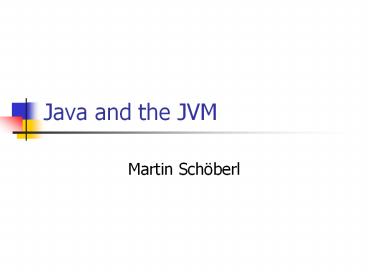Java and the JVM - PowerPoint PPT Presentation
Title: Java and the JVM
1
Java and the JVM
- Martin Schöberl
2
Overview
- History and Java features
- Java technology
- The Java language
- A first look into the JVM
- Disassembling of .class files
3
History of a Young Java
- 1992 Oak for a PDA on a SPARC (7)
- 1995 Official release as Java Internet
- 1997 picoJava Suns Java processor
- 1998 RTSJ specification start as JSR-01
- 1999 split into J2SE and J2EE
- 2000 J2ME
- 2002 RTSJ final release
- 2002 first version of JOP -)
4
Java features
- Simple and object oriented
- Look and feel of C
- Simplified object model with single inheritance
- Portability
- Java compiler generates bytecodes
- Runtime systems for various platforms
- Size and behavior of basic data types defined
- Write once, run/debug anywhere
5
Java features cont.
- Availability
- Windows, Linux, Solaris,
- Embedded systems
- Compiler and runtime are free
- Free IDEs Eclipse, Netbeans
- Library
- Rich class library
- Part of the definition
- Standard GUI toolkit
6
Java features cont.
- Built-in model for concurrency
- Threads at the language level
- Synchronization
- Libraries are thread-safe
- Safety
- No Pointer!
- Extensive compile-time checking
- Runtime checking
- Automatic memory management GC
7
Java system overview
8
Java Technology
- The Java programming language
- The library (JDK)
- The Java virtual machine (JVM)
- Instruction set
- Binary format
- Verification
9
Java Primitive Data Types
boolean either true or false
char 16-bit Unicode character (unsigned)
byte 8-bit integer (signed)
short 16-bit integer (signed)
int 32-bit integer (signed)
long 64-bit integer (signed)
float 32-bit floating-point (IEEE 754-1985)
double 64-bit floating-point (IEEE 754-1985)
10
Objects
- Everything belongs to an object (or a class)
- No global variables
- Namespace for objects
- Single inheritance
- Interfaces
- Allocated on the heap
- Shared among threads
- No free() garbage collector
11
What is a Virtual Machine?
- A virtual machine (VM) is an abstract computer
architecture - Software on top of a real hardware
- Can run the same application on different
machines where the VM is available
12
The Java Virtual Machine
- An abstract computing machine that executes
bytecode programs - An instruction set and the meaning of those
instructions the bytecodes - A binary format the class file format
- An algorithm to verify the class file
13
JVM cont.
- Runtime environment for Java
- Implementation NOT defined
- Runs Java .class files
- Has to conform to Suns specification
14
Implementations of the JVM
- Interpreter
- Simple, compact
- Slow
- Just-in-time compilation
- State-of-the-art for desktop/server
- Too resource consuming in embedded systems
- Batch compilation
- Hardware implementation
- Our topic!
15
JVM Data Types
reference Pointer to an object or array
int 32-bit integer (signed)
long 64-bit integer (signed)
float 32-bit floating-point (IEEE 754-1985)
double 64-bit floating-point (IEEE 754-1985)
- No boolean, char, byte, and short types
- Stack contains only 32-bit and 64-bit data
- Conversion instructions
16
Memory Areas for the JVM
- Method area
- Class description
- Code
- Constant pool
- Heap
- Objects and Arrays
- Shared by all threads
- Garbage collected
17
Memory Areas for the JVM
- Stack
- Thread private
- Logical stack that contains
- Invocation frame
- Local variable area
- Operand stack
- Not necessary a single stack
- Local variables and operand stack are accessed
frequently
18
JVM Instruction Set
- 32 (64) bit stack machine
- Variable length instruction set
- Simple to very complex instructions
- Symbolic references
- Only relative branches
19
JVM Instruction Set
- Load and store
- Arithmetic
- Type conversion
- Object creation and manipulation
- Operand stack manipulation
- Control transfer
- Method invocation and return
20
Dissassembling Java
- Compile
- javac Hello.java
- Run
- java Hello
- Dissassemble
- javap -c Hello
21
A Bytecode Example
- public class X
- public static void
- main(String args)
- add(1, 2)
- public static int
- add(int a, int b)
- return ab
- public static void main(java.lang.String)
- Code
- 0 iconst_1
- 1 iconst_2
- //Method add(II)I
- 2 invokestatic 2 5 pop
- 6 return
- public static int add(int,int)
- Code
- 0 iload_0
- 1 iload_1
- 2 iadd
- 3 ireturn
22
Coding Avoiding garbage
- System.out.println("Result "i)
- getstatic 3 // Field System.outLjava/io/PrintSt
ream - new 4 // class StringBuffer
- dup
- invokespecial 5 // StringBuffer."ltinitgt"()V
- ldc 6 // String Result
- invokevirtual 7 // StringBuffer.append(LString
)LStringBuffer - iload_1
- invokevirtual 8 // StringBuffer.append(I)LStrin
gBuffer - invokevirtual 9 // StringBuffer.toString()LStri
ng - invokevirtual 10// PrintStream.println(LString
)V
23
Coding Avoiding garbage
- System.out.print("Result ")
- System.out.println(i)
- getstatic 3 //Field System.outLjava/io/Pr
intStream - ldc 4 //String Result
- invokevirtual 5 //Method PrintStream.print(LS
tring)V - getstatic 3 //Field System.outLPrintStrea
m - iload_1
- invokevirtual 6 //Method PrintStream.println(
I)V
24
Java for Embedded Systems?
- Simpler than C/C
- Safer than C/C
- Threads are part of the language
- - Interpreting JVM is slow
- - JIT needs a lot of memory
- - GC and real-time?
25
Summary Java/JVM
- Java language definition
- Class library
- The Java virtual machine (JVM)
- An instruction set the bytecodes
- A binary format the class file
- An algorithm to verify the class file
26
Summary Java Features
- Safe OO Language
- No pointers
- Type-safety
- Garbage Collection
- Built in model for concurrency
- Platform independent
- Very rich standard library
27
More Information
- Java
- James Gosling, Bill Joy, Guy Steele, and Gilad
Bracha. The Java Language Specification,
Addison-Wesley, 2000, JavaSpec. - JVM
- Tim Lindholm and Frank Yellin. The Java Virtual
Machine Specification. Addison-Wesley, 1999,
JVMSpec.































